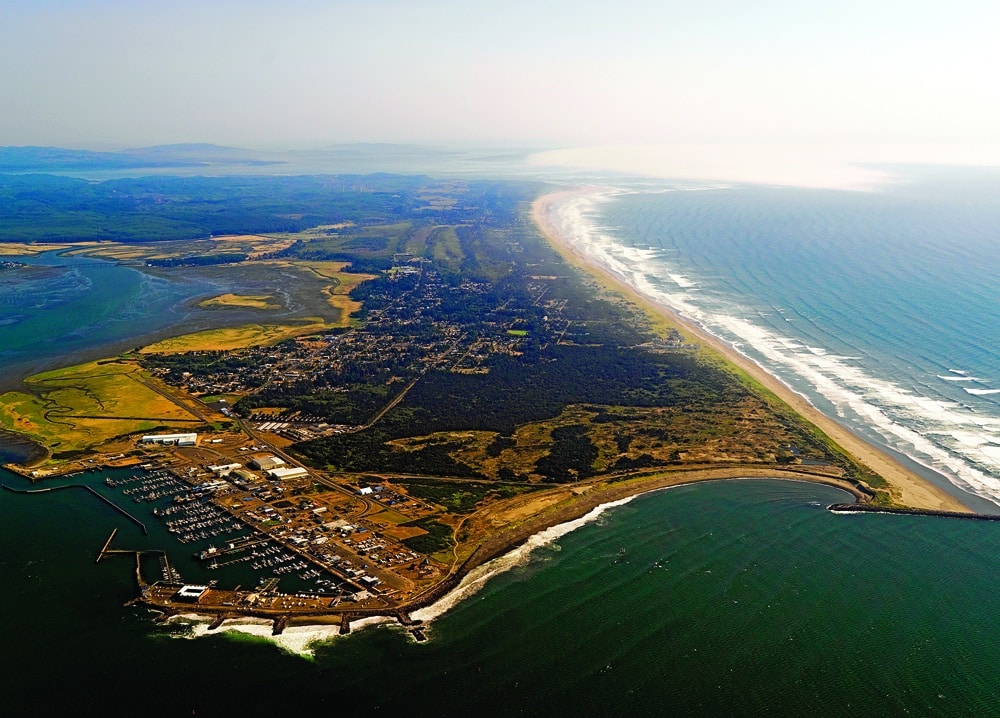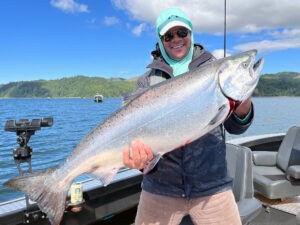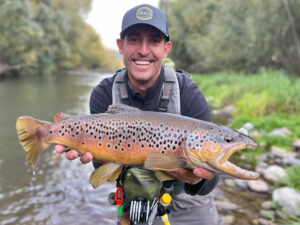Few other game fish incite as much hysteria among Pacific Coast anglers as do albacore. When schools of the longfin tuna show up within striking range, sport-fishing landings, marinas and launch ramps in three countries bustle with fishermen eager to get in on the offshore action.
Varying from 5-pound footballs to bruisers in the 50- to 60-pound class, the speedy albacore prove eager biters, tough fighters and fine table fare. These white-meat tuna are, after all, the fabled chicken of the sea. It’s hard not to love a fish with so many attributes.
Yet, there is one unpredictable variable. Albies sometimes sweep too far offshore, and remain outside the range of many boats on their summer/fall migration route northward along the Pacific coast of northern Mexico, California, Oregon, Washington, and British Columbia.
In recent years, for example, the longfins have been virtual no-shows for boats based in San Diego. At the same time, albie schools vectored closer to the coast up north, pleasing anglers from northern California to northern Vancouver Island.
When conditions are right and the longfins show, you go. In the -meantime, you can get your gear ready in anticipation of their arrival.
Albacore possess an affinity for purple-blue water and temperature breaks — changes of 2 to 5 degrees along which they can find and gorge on forage species such as anchovies, herring, squid, sardines, sauries, and other bait species. These temp breaks are often at the edges of the continental shelf, submerged canyons, underwater ridges and deep-sea mounts, all of which create upwellings of cooler water.
While bathymetric features might help guide your hunt, don’t get too hung up on fishing specific spots. Rather, look for signs of life to locate the tuna (see “Finding the Albacore”).
This year Mother Ocean might hold a wild card. A strong El Niño event could have an impact on the longfins’ timing and migration patterns. No one knows for sure, but albacore anglers hope it plays in their favor. Though this species seems to like temps around 59 to 62 degrees F, in El Niño years, I’ve caught them in water as warm as 72 degrees.
While anglers fish for longfins out of dozens of harbors and bays of North America’s Pacific coast, I’ve isolated 10 of the top ports for satisfying your albacore addiction. Join me as we follow the nomadic schools from south to north.
Ensenada, Mexico
There is scientific evidence to support the belief that vast schools of albacore circumnavigate the North Pacific, a route that finds them arcing east across the ocean in early summer, then angling north along the coast of Baja California Norte. That puts the port of Ensenada, Mexico, in the perfect position for an albie intercept. A fair number of U.S. anglers trailer their boats the 65 miles below the border, and launch at the Hotel Coral and Marina. Larger U.S. boats cruise down and stay in a guest slip at the marina, which also has a live-bait barge and the only fuel dock above Los Cabos, some 750 miles south. Productive banks lie within 30 to 50 nautical miles offshore.
Season: Mid-June to late September, sometimes into October
Charter Information: Ensenada Sportfishing
Best Launch Ramp: Hotel Coral and Marina Ramp
Live Bait: Hotel Coral and Marina bait barge
San Diego Bay, California
For decades, the San Diego Bay -sport-fishing passenger fleet depended on the annual albacore run for its very livelihood. Fishing waters 30 to 90 miles from Point Loma, anglers and albacore filled the boats that ran “turnaround” schedules virtually all summer out of landings such as Fisherman’s and H&M. Unfortunately, in recent years, schools of longfins proved -nonexistent — or perhaps too deep to catch — along the northern Baja and Southern California coasts, leaving anglers looking for other game. There are a number of theories about the missing albies, but some evidence indicates the albacore have taken to feeding in the abyss on benthic species such as laternfish along this portion of coast, thus not making themselves visible or accessible. Whatever the reason, anglers hope for a return of albie action to these waters, and if that happens, San Diego Bay will be a top longfin launch point.
Season: Mid-June through September
Charter Information: San Diego Sportfishing Online
Best Launch Ramp: Shelter Island Launch Ramp
Live Bait: Everingham Brothers bait barge
Morro Bay, California
Migrating schools of albacore often swing closer to the coast after they pass outside California’s Channel Islands and Point Conception, and one of the first ports to capitalize on this was Morro Bay. Anglers find fish anywhere from 20 to 70 miles from the iconic El Morro monolith that marks the entrance to the shallow bay. Weather is always a factor along this tempestuous and fully exposed stretch of the central California coast, with high winds and big waves sometimes thwarting the albacore chase, particularly for private-boat anglers. Yet when seas cooperate and the longfins are within range, the fishing can be spectacular for private, charter, and passenger boats alike.
Season: June through September
Charter Information: Morro Bay Landing
Best Launch Ramp: Morro Bay Launch Ramp
Live Bait: Morro Bay Landing (subject to shortages due to weather)
Santa Cruz, California
With Monterey Bay offering some protection from the wind and Monterey Canyon serving as natural underwater highway leading migrating albacore closer to shore, Santa Cruz Harbor on the upper side of the bay can serve as the launch point for some great albacore fishing. Autumn months see some of the best action for both private and charter boats, many of which are berthed at S-Dock on the east of the lower Santa Cruz Harbor.
Season: July through October
Charter Information: Fishing Santa Cruz
Best Launch Ramp: Santa Cruz Harbor Boat Launch
Live Bait: Boccie Boy Bait (subject to shortages due to weather)
Bodega Bay, California
Known to many as the setting for the bizarre Alfred Hitchcock film, The Birds, Bodega Bay — about 45 miles above San Francisco’s Golden Gate — becomes longfin central as offshore waters warm and schools of albacore migrate along the Northern California coast. Anglers switch from inshore tactics for salmon and rockfish to offshore trolling for tuna. While live bait is not available, anglers often experience multiple hookups on the troll. Like many northern coastal areas, the sea condition is a big consideration, especially when running 20 to 70 miles offshore to reach the albacore. When a calm weather window opens up, the chase begins.
Season: July through October
Charter Information: Fishing Bodega Bay
Best Launch Ramp: Westside Regional Park Boat Ramp
Live Bait: None
Crescent City, California
This northernmost California port on our list buzzes with excitement once the longfins are discovered, which can occur as early as July. The albies sometimes come as close as 20 miles off the coast, where trollers rack up impressive counts. As in most of the northern waters, live-bait fishing is rare. But some anglers keep schools close by chumming with copious amounts of chunk bait, and then cast-and-retrieve swimbaits and metal jigs (known as “iron”) to catch the frothing longfins on lighter tackle.
Season: July through October
Charter Information: Tally Ho II Sportfishing
Launch Ramp: Crescent City Harbor Boat Ramp
Live Bait: None
Coos Bay, Oregon
Boats out of Coos Bay are often the first to find longfins off the Oregon coast. Schools may sweep in as close as 25 miles, and if the weather is decent, trollers can fill the box in a hurry with fish in the 20- to 30-pound range. While live bait is rarely available in Coos Bay, anglers here seem to do just fine without it. As in Crescent City, anglers use chunk bait to keep a school close to the boat while fishing swimbaits.
Season: July through October
Charter Information: Fishing Oregon’s Adventure Coast
Best Launch Ramp: Charleston Marina and Launch Ramp in Coos Bay
Live Bait: None
Garibaldi, Oregon
Rivaling San Diego Bay as a premier longfin launch point, the port of Garibaldi on Tillamook Bay has all the key elements for albacore success, including a launch ramp close to the ocean, a live-bait operation, and albacore that zoom in pretty close to the coast. Anglers have caught longfins just 12 miles from the inlet, but most years, 20 to 25 miles is the closest you will find fish. Garibaldi also hosts one leg of the popular Oregon Tuna Classic. This year, the Garibaldi event takes place Aug. 22-23. When you find the longfins, it’s sometimes in the midst of a foaming frenzy of feeding that might cover acres of water. Toss in a live anchovy or -swimbait, and hang on.
Season: July through October
Charter Information: Garibaldi Charters
Best Launch Ramp: Garibaldi Marina Launch Ramp
Live Bait: Garibaldi Marina and Tillamook Bay Boathouse (subject to shortages due to weather)
Westport, Washington
Albacore have been known to vector as close as 15 miles from Westport, but you’re more likely to find them 35 miles or more off the Washington state coast, with some boats fishing as far as 60 miles. That kind of run begs for calm seas, lest your longfin adventure turn into a pounding hate mission. One of the first tip-offs of the season often comes from all-weather commercial trollers returning to port with their holds full of albacore. Armed with this intel, recreational fishermen get poised, then run out for longfins when breezes are light and waves are little.
Season: July through October
Charter Information: Westport Charter Boat Services, Washington Tuna Charters
Best Launch Ramp: Westport Marina Boat Launch
Live Bait: Westport Bait Dock (subject to seasonal availability)
Vancouver Island, Canada
Ports along the West Coast of British Columbia’s Vancouver Island, such as Ucluelet, Tofino and Kyuquot, are positioned for one last shot at the longfins before they turn westward on their suspected circle route around the North Pacific. At this northerly range, weather proves a bigger factor than anywhere else. Plus, the relatively warm water that holds albies is often 50 miles or more from the coast, though the longfins do come closer at times. Last year, even farther north, schools swung within 10 to 12 miles of the island for a short period in August. Trolling catches most of the fish, and action can be phenomenal, albeit fleeting. But then again, you can say that about albacore fishing anywhere.
Season: August through November
Top Charters: Tofino Fishing Charters, Murphy Sportfishing at Kyuquot
Best Launch Ramps: Tofino Boat Moorage Launch Ramp, Ucluelet District Boat Ramp
Live Bait: None
Finding the Albacore
Trolling feather jigs, Cedar Plugs and large deep-diving lures at about 7 knots with heavy tackle is the traditional method of finding albacore. This — in addition to searching for birds, jumping bait, temperature breaks and sometimes leaping albacore — is still the only way for many private-boat anglers.
Once a fish is hooked on the troll, the school often follows it to the boat, where anglers can then use lighter tackle with lures or bait such as live anchovies to hook more fish. Tossing out live “chummers” or chunks of bait helps keep the school around the boat to multiply the success of each “jig stop.”
The advent of searchlight sonar, however, has given skippers of passenger sport-fishing and some larger private boats a new tool for finding the tuna schools. While most boats still troll jigs for albacore, the fish are pinpointed with sonar, which can locate schools as far as 5,000 feet from the boat with an audible alarm to alert the skipper to a target. As the boat vectors in and circles on a sonar mark, a deckhand hurls netfuls of live bait or other chum to bring the fish close, often resulting in explosive action and instant hookups off the stern.
Longfin Facts
•Albacore can swim at speeds of more than 50 mph, so it’s nearly impossible to troll or retrieve a lure too fast for them when they want to eat it.
•Albacore need to eat a tremendous amount of food to fuel their life in the ocean fast lane, sometimes chowing down as much as 25 percent of their own weight every day. Little wonder, then, that they are eager biters.
•The IGFA all-tackle world-record -albacore was caught near the Canary Islands in the Atlantic in 1977. It weighed 88 pounds, 2 ounces.
•The IGFA record for an albacore in the Pacific was 83 pounds, 12 ounces, caught on a boat fishing out of Tokyo Bay, Japan, in 1984.
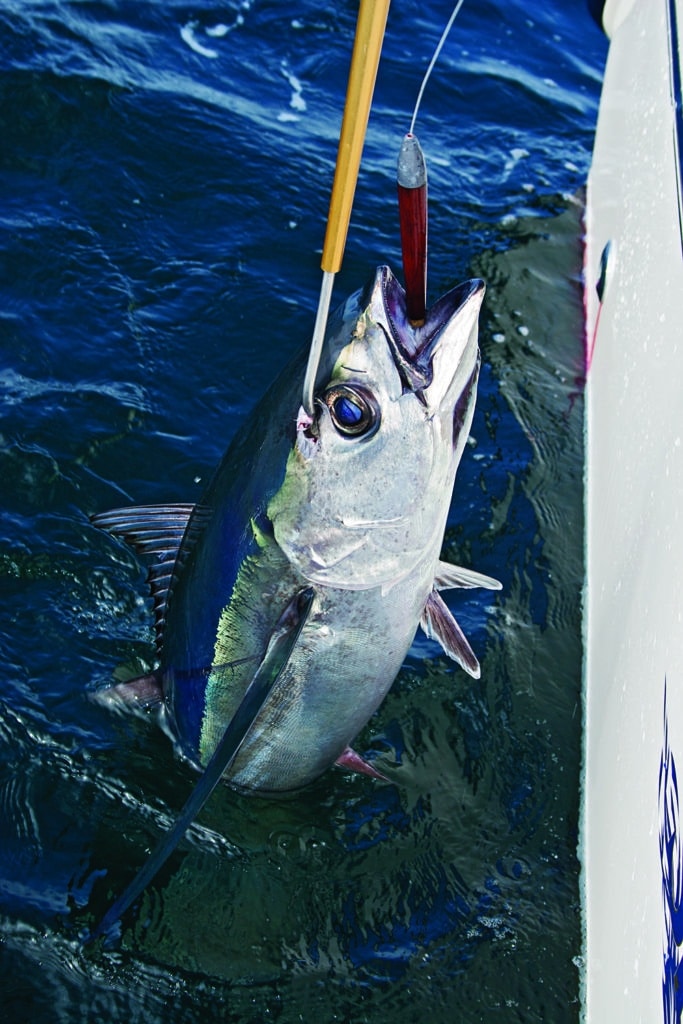
Albacore Tuna
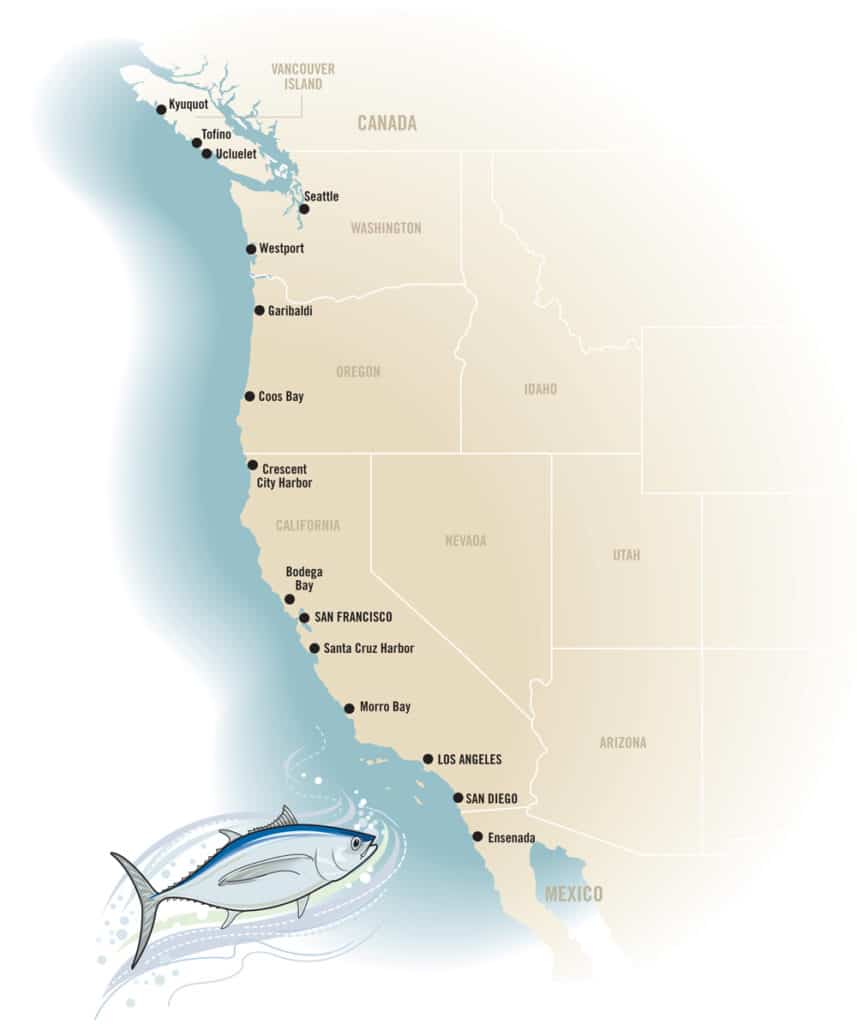
Albacore Migration Route
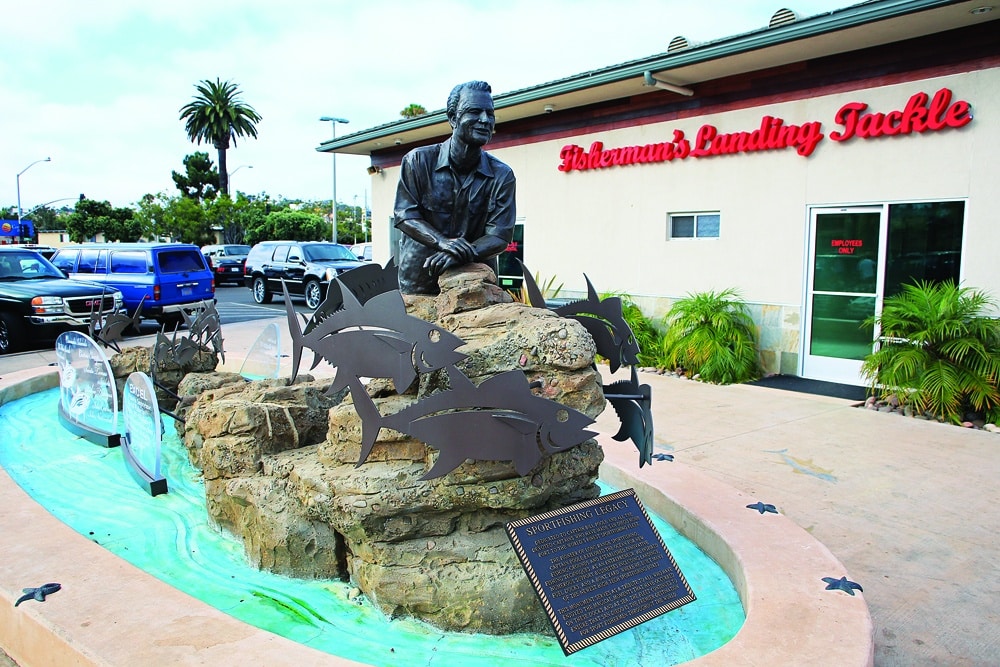
Legendary Launch Point
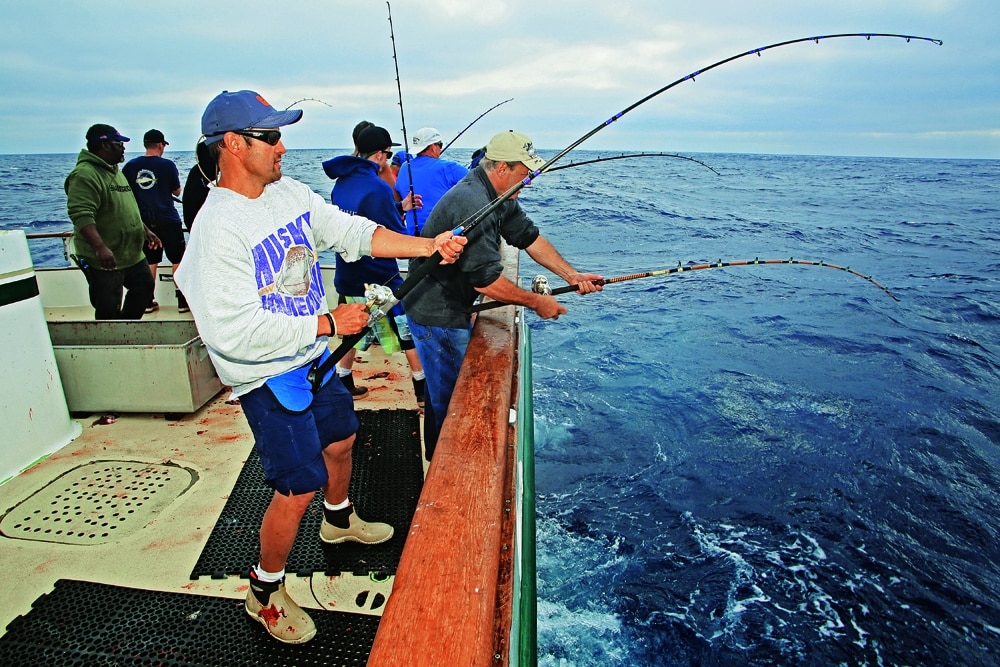
Albacore Action
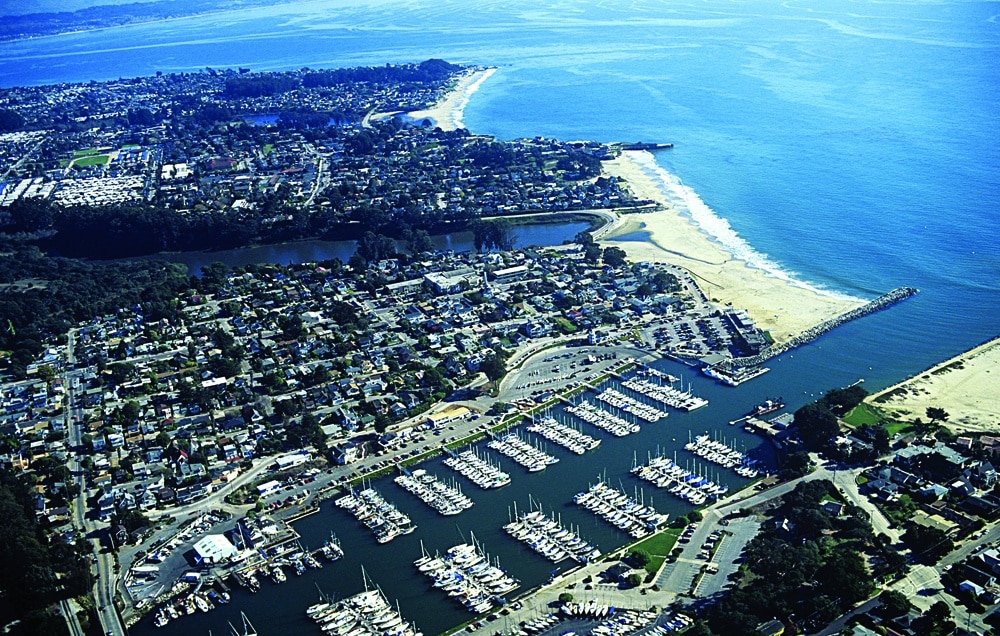
Santa Cruz, California
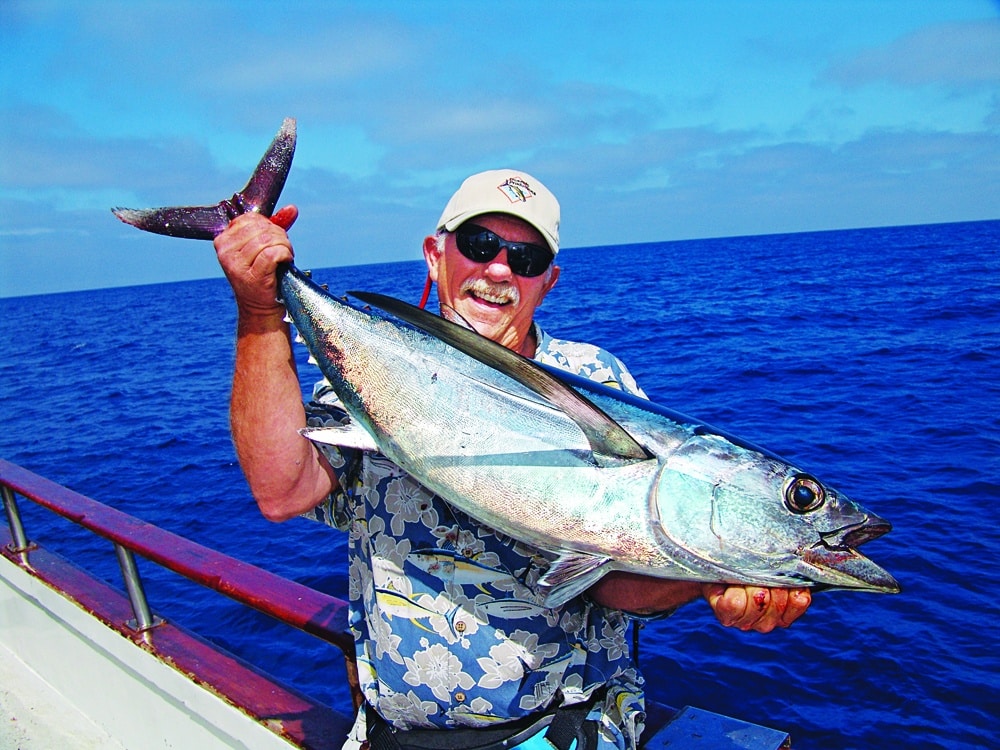
Lovely Longfin
